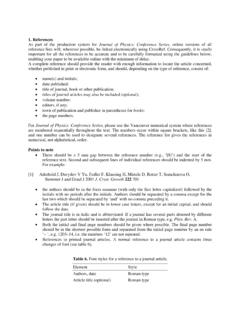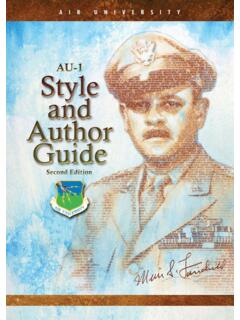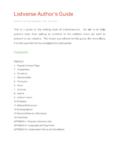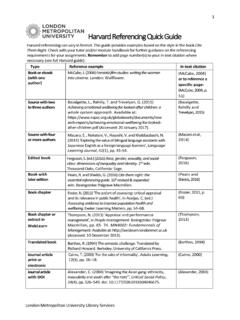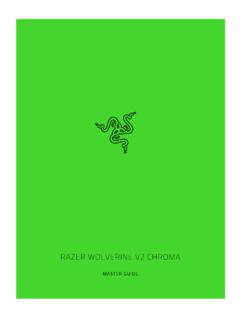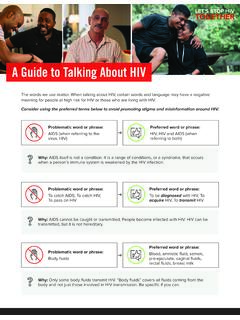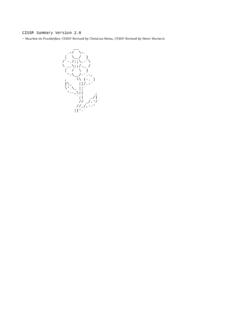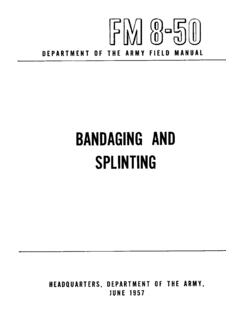Transcription of Preparing a paper for publication in IOP: Conference Series
1 Preparing a paper for publication inIOP: ConferenceSeriesJ Mucklow1and A Jansson21 Senior Production Editor, IOP Publishing, Bristol, UK2 Production Assistant, IOP Publishing, Bristol, guidelines (laid out in the recommended format of a published article)summarize the key requirements for an article to be published inIOP: Conference will not be edited, proofread or have changes made to the layout; thesubmitted PDF will be used for both online and print. It is, therefore, the author sresponsibility to ensure that the content and layout are correct no changes can be made Key requirementsThe following lists the essential requirements for an article to be published in anIOP: ConferenceSeriesjournal: the page size should be A4; each page should have clear margins of 4cm (top), (left and right) and (bottom); pages should not contain page numbers, running heads or footlines; all articlesmustcontain an abstract; in the PDF, all fonts should be Layout of the title pageThe title should be followed by a list of all authors names and their affiliations.
2 The style forthe names is initials (no periods) followed by the family name. The authors affiliations followthe author list. If there is more than one address then a superscripted number should comeat the start of each address; each author should also have a superscripted number or numbersfollowing their name to indicate which address, or addresses, are the appropriate ones for addresses may be given for any or all of the abstract follows the list of addresses. The abstract text should be indented 25 mm fromthe left margin. As the abstract is not part of the text it should be complete in itself; no tablenumbers, figure numbers, references or displayed mathematical expressions should be should be suitable for direct inclusion in abstracting The textThe text of your article should start on the same page as the abstract.
3 Any Acknowledgmentsshould be placed immediately after the last numbered section of the paper , and any appendicesafter the Acknowledgments length limit will be provided by the Figures and tablesFigures and tables should be numbered serially and positioned (centred on the width of thepage) close to where they are mentioned in the text, not grouped together at the end. Eachfigure and table should have a brief explanatory Colour figuresThere are no restrictions on the use of colour in the online version of your article. However,you should bear in mind that any print version of your article is likely to be in black and whitewhich may make coloured lines difficult to Supplementary dataWe are happy for authors to submit supplementary data attachments to enhance the onlineversions of published articles.
4 Supplementary data enhancements typically consist of videoclips, animations or supplementary data such as data files, tables of extra information or ReferencesOnline references will be linked to their original source or to the article within a secondaryservice such as INSPEC or ChemPort wherever possible. To facilitate this linking extra careshould be taken when Preparing reference complete reference should provide enough information to locate the article concerned inprint or electronic form. If you are unsure of a particular journal s abbreviated title it is bestto leave the title in full. The termsloc. not be References to printed journal articlesReferences to printed journal articles should typically contain: the authors , in the form: family name (only the first letter capitalized) followed by initialswith no periods after the initials; the year of publication ; the article title (optional) in lower case letters, except for an initial capital; the journal title (italic and abbreviated).
5 Parts denoted by letters should be inserted afterthe journal in Roman type; the volume number in bold type; the article number or the page A typical (numerical) reference listReferences[1] Strite S and Morkoc H 1992J. Vac. Sci. [2] Gusev A Aet al2011J. Phys.: Conf. Series291012052[3] Kurata M 1982 Numerical Analysis for Semiconductor Devices(Lexington, MA: Heath)[4] Kunze K 2003 T-duality and Penrose limits of spatially homogeneous and inhomogeneous (Preprintgr-qc/0303038)[5] Milson R, Coley A, Pravda V and Pravdova A 2004 Alignment and algebraically special tensorsPreprintgr-qc/0401010[6] Caplar R and Kulisic P 1973 Proc.
6 Int. Conf. on Nuclear Physics (Munich)vol 1 (Amsterdam: North-Holland)p 517[7] Kuhn T 1998 Density matrix theory of coherent ultrafast dynamics Theory of Transport Properties ofSemiconductor Nanostructures(Electronic Materials vol 4) ed E Sch oll (London: Chapman and Hall)chapter 6 pp 173 214
